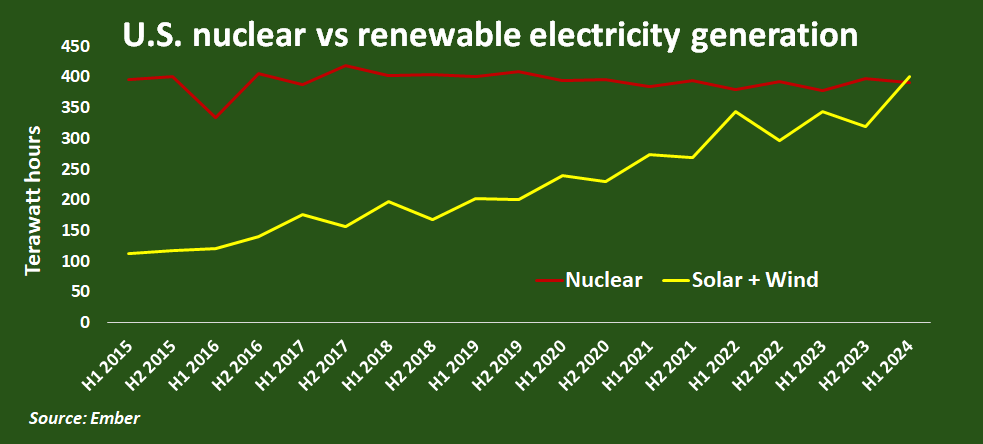US Solar And Wind Power Generation Tops Nuclear For First Time
By Charles Kennedy of OilPrice.com
For the first time ever, U.S. electricity generation from utility-scale solar and wind exceeded nuclear power plants’ power output in the first half of 2024, according to data from energy think tank Ember quoted by Reuters columnist Gavin Maguire.
Electricity generation from solar and wind hit a record-high of 401.4 terawatt hours (TWh) between January and June 2024, surpassing the 390.5 TWh of power generated from nuclear power plants, Ember’s data showed.
Solar power generation jumped by 30% and electricity output from wind power rose by 10% in the first half of 2024, compared to the same period of last year.
In 2023, nuclear power accounted for 18.6% of U.S. electricity generation, while wind power output had a 10.2% share and solar accounted for 3.9% of total U.S. electricity output, according to data for 2023 from the U.S. Energy Information Administration (EIA).
Ember has estimated that the share of wind and solar grew to 16% in 2023, when nuclear was still the largest source of low-carbon electricity in the U.S.
However, expanding renewable energy capacity and record solar and wind power generation helped solar and wind combined to top nuclear as the biggest low-carbon electricity source during the first half of this year.
Early in 2024, the EIA said that wind and solar energy would lead growth in U.S. power generation for the next two years.
As a result of new solar projects coming on line this year, the administration forecast that U.S. solar power generation will surge by 75%, from 163 billion kilowatt-hours (kWh) in 2023 to 286 billion kWh in 2025. The EIA also expects that wind power generation will grow by 11% from 430 billion kWh in 2023 to 476 billion kWh in 2025.
In 2023, all renewable sources—wind, solar, hydro, biomass, and geothermal—accounted for 22% of total U.S. power generation.
NEVER MISS THE NEWS THAT MATTERS MOST
ZEROHEDGE DIRECTLY TO YOUR INBOX
Receive a daily recap featuring a curated list of must-read stories.



